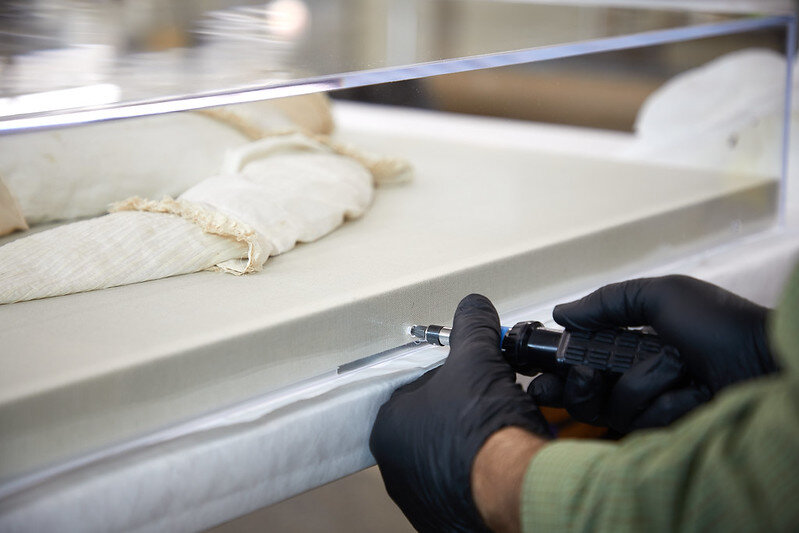Whatever it is, the way you tell your story online can make all the difference.
Spring is the time for weddings, as the weather is warming and the flowers are in bloom. This month, we had the pleasure of preserving an antique wedding dress made in 1900 from the Elk Grove Historical Museum located in Elk Grove Village, Illinois. According to their records, the dress was worn by Clara Schuette, who grew up in the museum’s farmhouse and married Henry Luehring on April 4th, 1901 in the museum’s parlor.
Clara wearing her wedding dress under a jacket, and her husband, Henry, 1901. Photo courtesy of the Elk Grove Historical Museum.
Luehring family photo circa 1920. Photo courtesy of the Elk Grove Historical Museum.
The dress consists of many different pieces made in both cotton and silk fabrics. The skirt and bodice are made of a fine cotton with silk covered pleating and ruffled details. The sash and dress panel are both made of silk, but the panel in particular was in poor condition. When silk gets old, and particularly if it has been exposed to light, the fibers lose their integrity, become brittle and break down into a condition referred to as “shattered.” This had unfortunately happened to the dress panel. Additionally, the dress was yellowed with surface soiling and stains overall.
Before Treatment
Our team photographed the wedding dress as it arrived at The Center, and then it was sent to our textile conservator for treatment. The first step in treatment was cleaning. “Cleaning old textiles is the most difficult part of any conservation,” our textile specialist revealed. “It’s not reversible so you have to be extremely careful.” Antique fabric like this should never be cleaned in a conventional washer, and even a trip to the dry cleaners can have detrimental effects. To mitigate further damage of your textiles, make sure to do extensive research or reach out to a professional before cleaning.
During Treatment
During Treatment
During Treatment
Cleaning textiles can be stressful to the piece, so conservators must weigh the risks and benefits and consider treatment options carefully. Because of the different fabrics and varying levels of staining, a few different methods of cleaning were executed for this project. One of the two collars, a pleated cotton, was not able to be wet washed because it was lined with a natural linen buckram which might have stained the cotton if immersed in water. This piece was surface cleaned using dry methods instead.
Vitrine Installation
The rest of the dress was supported with mesh and wet washed in deionized water and a mild surfactant. Wet cleaning is important for not just aesthetic reasons, but it also helps remove accumulated acids from the environment and stains that can be very detrimental to the piece. Some stains, however, were unable to be fully removed due to the fragility of the fabric.
Vitrine Installation
Vitrine Installation
The piece was then stitched back together and reassembled in its original form. Since the panel was “shattered,” our conservator was no longer able to use a needle and thread to stabilize damage because the needle would crack the brittle fabric. Instead, he encapsulated it with a transparent tulle to hold all the pieces together.
After Treatment
After Treatment
Our conservator was also in close contact with the museum curator at Elk Grove to discuss display options for the dress. After many layouts were proposed, the museum selected to have the dress stitch mounted to a linen covered stretcher. The bodice of the dress was gently padded, and the skirt was arranged into folds to help lift the dress from the background. The display was encased in a custom conservation-grade Museum Acrylic vitrine, which is anti-reflective, anti-static, and protects from UV light rays. It was backed with a Coroplast backing board for extra protection.
After Treatment
After Treatment
“After 120 years, Clara’s wedding dress can be exhibited to share her story with our community, which would not have been possible without The Conservation Center’s expertise.”
The dress will be on temporary display in the Elk Grove Historical Museum parlor from May 15 to November 26, 2021.
After Treatment















